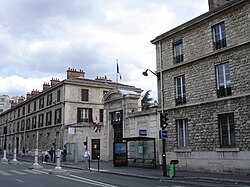Necker–Enfants Malades Hospital
| Necker–Enfants Malades Hospital | |
|---|---|
Assistance Publique – Hôpitaux de Paris | |
 | |
 | |
| Geography | |
| Location | 149 rue de Sèvres 75015 Paris, France |
| Organisation | |
| Type | Teaching |
| Affiliated university | University of Paris |
| Services | |
| Emergency department | Yes |
| Beds | 600 |
| Speciality | Pediatrics |
| History | |
| Opened | 1920 by merger of Necker Hospital (founded 1778) and Sick Children's Hospital (founded 1801) |
| Links | |
| Website | hopital-necker |
| Lists | Hospitals in France |
The Necker–Enfants Malades Hospital (
History
The Hôpital Necker was founded in 1778 by Madame Necker, born
The Hôpital des Enfants Malades (Hospital for Sick Children), not to be confused with the foundling hospital, the Hôpital des Enfants Trouvés, was created by the Conseil général des Hospices (General Hospices Council) in January 1801 to help manage the health and social structures of Paris. With the aim of reorganising the hospital, the Council proposed a new classification based on the common distinction between hospitals and special hospitals and announced the creation of a hospital "for the children of both sexes under the age of fifteen years" (4 December 1801). The newly formed Hôpital des Enfants Malades opened in June 1802 on the site of the previous orphanage hospital Hôpital de l'Enfant Jésus ("Baby Jesus hospital"). It was the first paediatric hospital in the Western world.[3]
The two physically contiguous hospitals were merged in 1920, but the Necker division continued to care for adults and Enfants malades for children.[citation needed]
Mural
In 1987, American artist,
The stairwell became derelict over time and paint worn off and was condemned by hospital's administrators.[7] However, it was conserved and fully restored in September 2017. The attached surgery center the stairwell had once attached to had been demolished and a new hospital building had been constructed. The mural now stands as a "totem" and centerpiece of the hospital gardens.[7]
Famous Physicians
French physician
Among eminent physicians working at the Hôpital des Enfants Malades were Auguste Chaillou, Eugène Bouchut, Director Jacques-Joseph Grancher), Director Victor Henri Hutinel, Eugène Apert and Édouard Kirmisson.
Gallery
-
The entrance of Hôpital des Enfants malades in Rue de Sèvres.
-
Laennec's memorial tablet in the front of the old hospital. "Here, Laennec discovered the Stethoscope".
-
Entrance of the historical Necker hospital ("Carré Necker").
See also
References
- ^ ISBN 0-19-505523-3.
- ISBN 0-19-505523-3.
- ISBN 0-88167-695-0.
- ^ Juliette Hardy & Marine Leroy. "PRESS RELEASE: Inauguration of "Tower", the restored tower of the American artist Keith Haring, thanks to the support of numerous sponsors and partners" (PDF).
- ^ "The complex preservation of Keith Haring's 1987 mural at the Hopital Necker des Enfants Malades, Paris by Will Shank + Antonio Rava | International Institute for Conservation of Historic and Artistic Works". www.iiconservation.org. Retrieved 2018-05-25.
- ^ "Paris Mural | Keith Haring". www.haring.com. Retrieved 2018-05-26.
- ^ a b Sulcas, Roslyn (7 September 2017). "An 88-Foot-High Keith Haring Mural Is Restored in Paris". The New York Times.
- PMID 17048358.
- ISBN 978-0-521-27205-6.
"The relevance of the hospital to his work was obvious; so was the relevance of the work to the hospital, where Bayle had reported, of 696 deaths, 244 were from phthisis.
- ^ Laennec, René (1962). A Treatise on the Diseases of the Chest. New York: Hafner Publishing Company. pp. 297–301.



